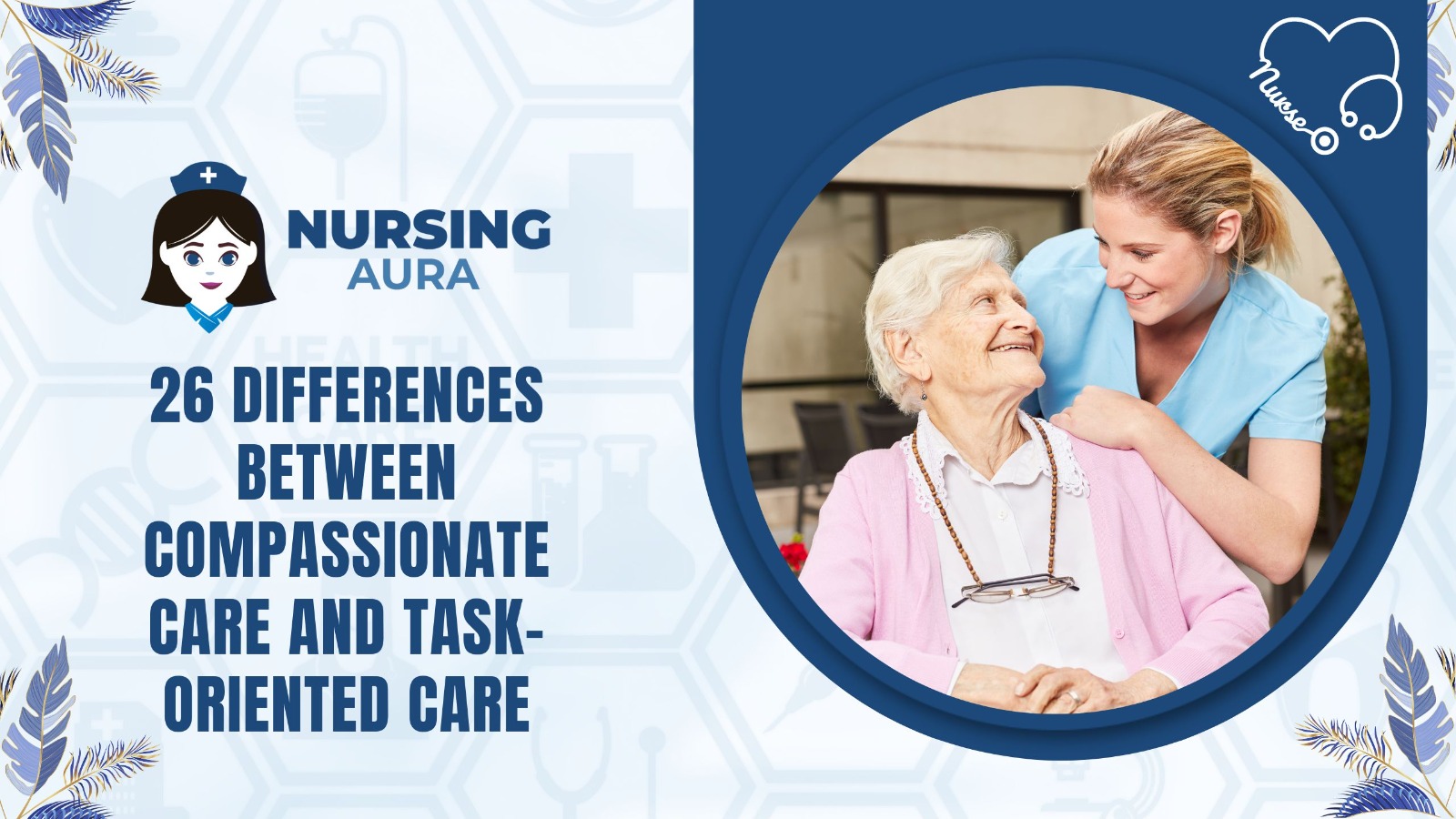Compassionate and task-oriented care focuses on various patient well-being and treatment. Both are necessary for complete healthcare, but their delivery differs. Compassionate care prioritizes mental health. It tackles physical and mental symptoms of disease and injury, which can be emotionally draining. Compassionate doctors encourage empathy, active listening, and real concern for patients’ worries. Compassionate care treats the patient as a full person with emotional and spiritual needs, not just symptoms or tasks.
While task-oriented care emphasizes technical aspects of healthcare delivery, healthcare providers who follow this method perform certain surgeries and treatments efficiently and accurately. Task-oriented care prioritizes medical responsibilities over patient emotional and psychological needs, yet it is necessary. It’s frequently seen as a mechanical or formulaic approach to healthcare that prioritizes diagnosis and treatment over patient experience or emotion.
Quality healthcare requires both compassionate and task-oriented care, notwithstanding their disparities. Patients may need medical expertise and emotional support, therefore a balanced approach is often needed. This equilibrium improves patient satisfaction and outcomes. Healthcare providers also tailor their therapy to each patient’s needs, knowing that some need empathic and others task-oriented care.
Finally, compassionate and task-oriented healthcare are complementary. While task-oriented care focuses on physical processes, compassionate care prioritizes mental health to build trust and empathy. To provide the best care, holistic healthcare needs to balance both methods.
26 differences between Compassionate Care and Task-Oriented Care:
| S.No. | Aspects | Compassionate Care | Task-Oriented Care |
| 1 | Definition | Focuses on providing care with empathy, understanding, and kindness to meet emotional, social, and psychological needs. | Concentrates on completing specific tasks and procedures efficiently to meet physical care needs. |
| 2 | Emphasis | Prioritizes the emotional and holistic well-being of the patient. | Primarily emphasizes completing tasks and procedures according to a set routine. |
| 3 | Approach | Takes a person-centered approach, addressing individual patient preferences and concerns. | Follows a routine or protocol-centered approach to care delivery. |
| 4 | Relationship Building | Establishes strong nurse-patient relationships through empathy and active listening. | May not prioritize relationship building as much as task completion. |
| 5 | Communication | Encourages open and compassionate communication with patients and their families. | Focuses on communicating task-related information and updates to patients. |
| 6 | Patient Empowerment | Empowers patients to participate in decision-making and care planning. | May involve patients in decisions but is more task-driven. |
| 7 | Flexibility | Adapts care plans based on individual patient needs and preferences. | May have less flexibility in care plans, following established protocols. |
| 8 | Emotional Support | Provides emotional support, reassurance, and comfort to patients and families. | Offers support primarily through the completion of tasks. |
| 9 | Holistic Perspective | Takes a holistic view of the patient, addressing physical, emotional, social, and spiritual needs. | Primarily addresses the patient’s physical and medical needs. |
| 10 | Patient-Centered Care | Prioritizes patient-centered care, tailoring interventions to the patient’s unique circumstances. | May provide patient-centered care but with a primary focus on task completion. |
| 11 | Empathy | Demonstrates empathy and compassion in interactions with patients and their families. | Focuses on the technical aspects of care delivery rather than emotional connection. |
| 12 | Decision-Making | Involves patients and families in care decisions, considering their values and preferences. | Decisions are typically made based on medical necessity and established protocols. |
| 13 | Personalized Care | Offers personalized care plans based on the patient’s individual needs and preferences. | Care plans may be standardized and less personalized. |
| 14 | Psychological Support | Addresses the patient’s psychological well-being and offers emotional support. | May not place as much emphasis on addressing psychological aspects of care. |
| 15 | Patient Satisfaction | Often results in higher patient satisfaction due to the compassionate and empathetic approach. | May lead to lower patient satisfaction if the focus is solely on task completion. |
| 16 | Pain and Symptom Management | Manages pain and symptoms with a compassionate and holistic approach. | Manages pain and symptoms based on medical protocols and guidelines. |
| 17 | Dignity and Respect | Respects and preserves the patient’s dignity and autonomy throughout care. | Respects dignity but may prioritize task completion over autonomy. |
| 18 | Care Planning | Engages in collaborative care planning with patients and families. | Care planning may involve healthcare providers but with less patient involvement. |
| 19 | Time Allocation | May require more time for patient interactions and emotional support. | May focus on task efficiency, potentially resulting in shorter interactions. |
| 20 | Caregiver Well-Being | May lead to caregiver satisfaction and a sense of fulfillment. | May lead to caregiver burnout if tasks take precedence over emotional care. |
| 21 | Care Documentation | Documents not only the tasks performed but also emotional and social aspects of care. | Primarily documents task-related information and medical data. |
| 22 | Family Involvement | Involves and supports the patient’s family, addressing their emotional needs as well. | May involve family but with a primary focus on the patient’s care tasks. |
| 23 | Burnout Prevention | Compassionate care may help prevent caregiver burnout through emotional connections. | Task-oriented care may lead to caregiver burnout due to the stress of task completion. |
| 24 | Care Continuity | Prioritizes care continuity by considering the patient’s emotional and social needs. | Ensures care continuity primarily by following established protocols. |
| 25 | Quality of Life | Aims to improve the patient’s overall quality of life through compassionate care. | May primarily focus on extending and sustaining life through medical care. |
| 26 | Patient-Centered Outcomes | Focuses on patient-centered outcomes, such as emotional well-being and satisfaction. | May prioritize clinical outcomes and adherence to treatment plans. |
Frequently Asked Questions (FAQs)
1. What separates compassionate from task-oriented care?
Compassionate care prioritizes patient well-being, empathy, and emotional support. It reduces anxiety via meaningful relationships, active listening, and reassuring. However, task-oriented care emphasizes efficient medical processes employing protocols and checklists. Task-oriented care is clinical, while compassionate care is emotional and psychological.
2. Why is compassionate healthcare important?
Compassion enhances patient outcomes, trust, and experience. Emotionally supported and understood patients are more likely to continue treatment regimens, experience less anxiety, and be satisfied with their doctors. Compassionate care enhances patient-provider communication, improving diagnosis and treatment.
3. Is compassionate care more critical than task-oriented?
Empathy and task-oriented care are equally important but in different ways. To ensure accurate and consistent treatment, medical tasks must be accomplished quickly. Task-oriented care enhances patient safety, medical protocols, and healthcare goals. Complete patient-centered care requires balancing compassionate and task-oriented care.
4. Can task-oriented and empathetic care be combined?
Patient-centered care is usually caring and task-oriented. Medical staff can properly treat patients’ emotional and psychological requirements. This integrated approach recognizes that patients have various emotional responses to therapy. Healthcare practitioners treat more comprehensively with empathy and clinical knowledge.
5. How can healthcare firms promote employee compassion?
Healthcare staff trained in empathy, active listening, and communication may provide compassionate care. Rewarding healthcare providers may also promote empathy and patient-centered care. By using patient feedback systems and reviewing often, healthcare firms may improve compassion. A supportive work environment that acknowledges the emotional toll of caring may also assist healthcare workers provide compassionate care.

